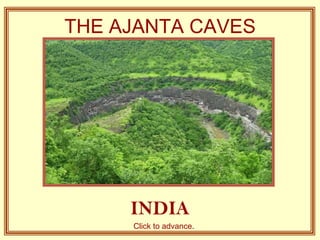
Ajanta caves
- 1. THE AJANTA CAVES INDIA Click to advance.
- 2. Little more than two hours from the old city of Aurangabad are the famous Caves of Ajanta, Thirty-two grottos that are not natural but had been cut in hills for thousands of years by workers who had only used cinzéis and hammers.
- 3. General view of the place
- 6. The oldest cave traces to the second century before Christ. Some of them are Viharas (convents) or monasteries, great chambers with small rooms that lead off the main room and it was where they lived as monks. Some of these rooms have beds of cut rock, with a cushion in which monks could rest their heads.
- 8. Plate in the entrance of the caves
- 9. The caves of Ajanta
- 10. One of the entrances of the caves
- 11. It is surprising to think that the great masters who had created these wonders used only small tools of work. Still they had thus bequeathed us something universal and magical that we can contemplate today. The centuries seem like small water drops in the Walls of these caves.
- 12. One of the entrances
- 13. Two elephants in one of the doors
- 14. Rio Vaghora
- 15. Sculptured in the volcanic basalt rock, the craftsmen had been meticulously ‘cinzelando’ the rock little by little, cutting the columns in strategic places and creating some rooms inside of the rock. The walls and ceilings had been wonderfully decorated and had created colorful paintings with plaster applications .
- 17. 32 caves are excavated in the rock
- 18. Some caves are monasteries
- 19. In the central section (where a Christian church would have its altar) might be a great statue of Buddha. Remember that these temples of rock had been cut many centuries before the Christian cathedrals, which can lead us to speculate whether they had been the inspiration for the great architects of the Medieval Age, and not the Greek and Roman classic temples.
- 20. A great reclined Buddha
- 21. Interior
- 23. Sculptured in the volcanic basalt rock, the craftsmen had been meticulously ‘cinzelando’ the rock little by little, cutting the columns in strategic places and creating some rooms inside of the rock.
- 26. The remaining portion of the caves are Chaityas or temples, very similar to Christian cathedrals, with ceilings ‘abobodados’ with cross-ribbed wooden beams, and with decorated pillars of rocks. .
- 28. A Hindu family admires the work of its ancestor
- 32. The majority of paintings are more than 1500 years old. Ten centuries before the birth of Michelangelo, Leonardo da Vinci and the European Renaissance, these unknown artists already knew how to use perspective, depth and realism in their paintings. The expressions and emotions captured in the faces of the painting are so real that today, after some centuries, they can still be admired.
- 34. frescos in the walls
- 37. The walls and ceilings had been wonderfully decorated and had created colorful paintings with plaster applications.
- 48. Guard who takes care of of the entrance
- 49. END